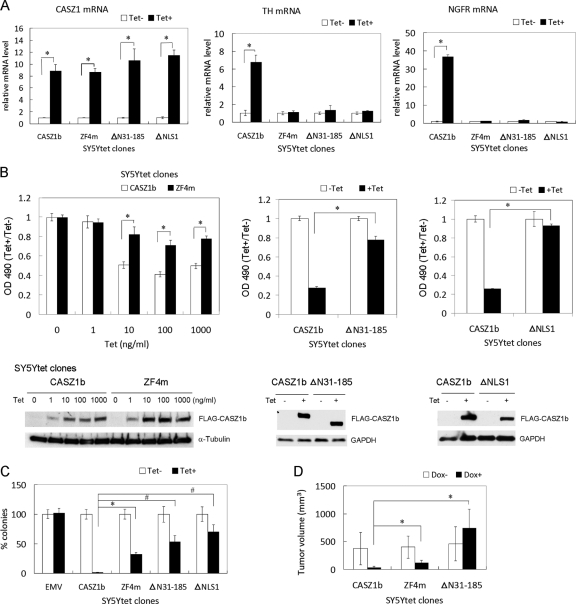Fig 8.
CASZ1b variants are less efficient than WT CASZ1b at inhibiting neuroblastoma cell proliferation and tumor growth. (A) Quantitative PCR was used to assess relative levels of CASZ1b, TH, and NGFR mRNA after 24 h of Tet (1 μg/ml) treatment in SY5Ytet cells that have been stably transfected with Tet-inducible WT, ZF4m, Δ31-185, or ΔNLS1 CASZ1b. The mRNA levels of WT CASZ1b and the variants were significantly upregulated compared to those of noninduced control cells (left panel; *, P < 0.02). TH and NGFR mRNA levels were significantly upregulated by WT CASZ1b but not by ZF4m, Δ31-185, or ΔNLS1 CASZ1b (middle and right panels, respectively; *, P < 0.005). (B) The left panel shows the MTS assay of SY5YtetCASZ1b and ZF4m cells treated with different amounts of Tet for 3 days. ZF4m is about 2-fold less effective than WT CASZ1b at suppressing cell proliferation (*, P < 0.0001). The middle panel shows the MTS assay of SY5YtetCASZ1b and Δ31-185 cells treated with Tet (1 μg/ml) for 6 days. Δ31-185 CASZ1b is less effective than WT CASZ1b at suppressing cell proliferation (*, P < 0.0001). The right panel shows the MTS assay of SY5YtetCASZ1b and ΔNLS1 cells treated with Tet (1 μg/ml) for 6 days. ΔNLS1 CASZ1b is less effective than WT CASZ1b at suppressing cell proliferation. *, P < 0.0001. A Western blot analysis of steady-state proteins from SY5YtetCASZ1b and CASZ1b mutant cells after 24 h of treatment with Tet is shown at the bottom of panel B. (C) Soft agar assay showing a 30-fold to 70-fold decrease in the ability of CASZ1b variants to inhibit the clonogenicity of SY5Y cells compared to that of WT CASZ1 (*, P < 0.003; #, P < 0.02). (D) SY5YtetCASZ1b, ZF4m, or Δ31-185 cells were subcutaneously injected into nude mice for 4.5 weeks. ZF4m and Δ31-185 CASZ1b are less effective than WT CASZ1b at suppressing tumor growth in the xenografts (n = 9 or 10 mice per group; volume = [length × width2]/4; *, P < 0.0005). Data are the means ± SDs.

